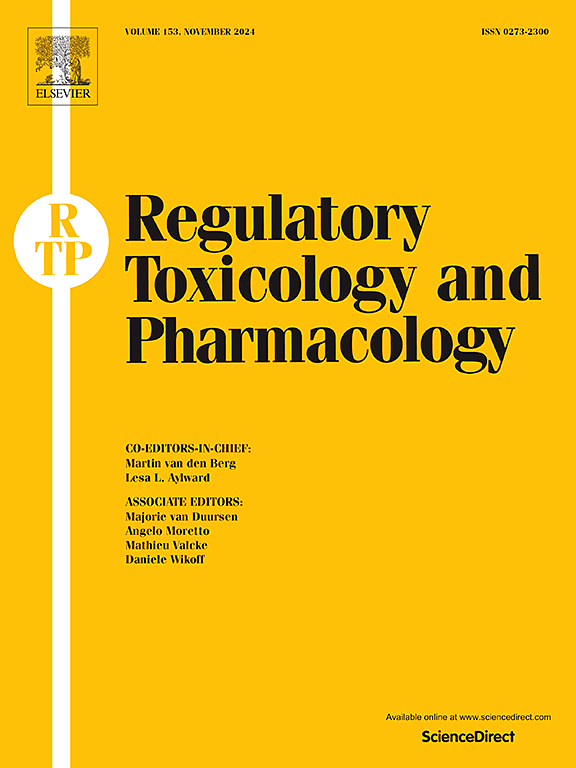专家小组对1,4-二恶烷的肿瘤作用方式及其对人类风险评估的影响的评估。
IF 3.5
4区 医学
Q1 MEDICINE, LEGAL
引用次数: 0
摘要
作用方式(MOA)在风险评估(包括低剂量外推)的关键决策中发挥着重要作用。为了支持对1,4-二恶烷(1,4- dx)依赖于MOA的决定,一个独立的专题专家小组评估了啮齿动物研究中报道的关于MOA和1,4- dx肿瘤与人类相关性的现有证据。专家组考虑了啮齿类动物肝脏肿瘤以及其他组织部位(鼻腔、腹膜间皮瘤)的MOA数据。对于肝脏肿瘤,小组成员发现间接基因毒性MOA最有力的支持,涉及代谢1,4- dx (CYP2E1)的酶的代谢饱和,随后是CYP2E1的诱导、氧化应激、细胞毒性和再生增殖。代谢饱和被确定为早期关键事件。虽然鼻肿瘤和腹膜肿瘤的证据有限,但类似的非基因毒性moa被认为是合理的。对于所有三种肿瘤类型,来自小组的最佳支持MOA(+2.5至+3.3)的置信度评分(-5至+5)明显高于直接基因毒性MOA(-3.8至-4.5)的置信度评分。该独立小组的结论包括仔细考虑最近发表的研究,为在1,4- dx啮齿动物肿瘤的人类健康风险评估中使用非线性外推法提供了支持。本文章由计算机程序翻译,如有差异,请以英文原文为准。
Expert panel evaluation of the tumor modes of action for 1,4-dioxane and their implications for human risk assessment
Mode of action (MOA) plays an important role in key decisions made in risk assessments, including that for low-dose extrapolation. To support MOA-dependent decisions for 1,4-dioxane (1,4-DX), an independent panel of topic experts evaluated the available evidence on the MOA and human relevance of 1,4-DX tumors reported in rodent studies. The panel considered MOA data on liver tumors in rodents, as well as for other tissue sites (nasal cavity, peritoneal mesothelioma). For liver tumors, the panelists found strongest support for an indirect genotoxic MOA involving metabolic saturation of the enzyme that metabolizes 1,4-DX (CYP2E1), followed by induction of CYP2E1, oxidative stress, cytotoxicity, and regenerative proliferation. Metabolic saturation was identified as an early key event. Although available evidence for nasal and peritoneal tumors was limited, similar non-genotoxic MOAs were considered plausible. For all three tumor types, confidence ratings (scale of −5 to +5) from the panel for the best supported MOAs (+2.5 to +3.3) were significantly higher than the confidence rating for a direct genotoxic MOA (−3.8 to −4.5). The conclusions from this independent panel, which included careful consideration of recently published studies, provide support for use of non-linear extrapolation methods in human health risk assessment for 1,4-DX rodent tumors.
求助全文
通过发布文献求助,成功后即可免费获取论文全文。
去求助
来源期刊
CiteScore
6.70
自引率
8.80%
发文量
147
审稿时长
58 days
期刊介绍:
Regulatory Toxicology and Pharmacology publishes peer reviewed articles that involve the generation, evaluation, and interpretation of experimental animal and human data that are of direct importance and relevance for regulatory authorities with respect to toxicological and pharmacological regulations in society. All peer-reviewed articles that are published should be devoted to improve the protection of human health and environment. Reviews and discussions are welcomed that address legal and/or regulatory decisions with respect to risk assessment and management of toxicological and pharmacological compounds on a scientific basis. It addresses an international readership of scientists, risk assessors and managers, and other professionals active in the field of human and environmental health.
Types of peer-reviewed articles published:
-Original research articles of relevance for regulatory aspects covering aspects including, but not limited to:
1.Factors influencing human sensitivity
2.Exposure science related to risk assessment
3.Alternative toxicological test methods
4.Frameworks for evaluation and integration of data in regulatory evaluations
5.Harmonization across regulatory agencies
6.Read-across methods and evaluations
-Contemporary Reviews on policy related Research issues
-Letters to the Editor
-Guest Editorials (by Invitation)

 求助内容:
求助内容: 应助结果提醒方式:
应助结果提醒方式:


